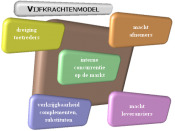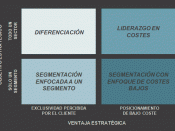Introduction.
'Competitive strategy is the bases on which a business unit might achieve competitive advantage in its market '.
There are two factors for a firm to be profitable: the fetching appearance of the industry in which it operates and its position in this industry.
The best known and most used set of competitive strategies are Michael Porter's Generic Strategies; he calls these generic strategies because they can be applied to a firm in any industry.
A firm creates a defendable position in an industry by its strengths thus Michael Porter argued that in the end all the firms choose between two strengths: cost advantage and differentiation. Porter said that to be at the top of an industry you must improve in terms of cost (cost advantage) or carry out task or products better than competitors (differentiation).
If we apply these strengths in a broad or narrow scope we will obtain the three generic strategies: cost leadership, differentiation and focus.
The following table illustrates Porter's generic strategies :
Target ScopeAdvantage
Low CostProduct Uniqueness
Broad
(Industry Wide)Cost Leadership
StrategyDifferentiation
Strategy
Narrow
(Market Segment)Focus
Strategy
(low cost)Focus
Strategy
(differentiation)
Cost leadership.
This generic strategy is based in following a cost strategy; that is to say, it tries to produce the lowest cost but always with a certain quality level. This can be obtained if they achieve to gain the exclusive features of certain row materials at low price or reducing cost in the producing process.
If the company manages to produce at low cost it will be able to follow a strategy of low price, which always aims to have lower price than its competitors, earning profit and maintaining a similar or superior quality level the one of the competition. This strategy is normally used in broad markets.



Thank you
It helped me on my exam, thank you.
1 out of 1 people found this comment useful.